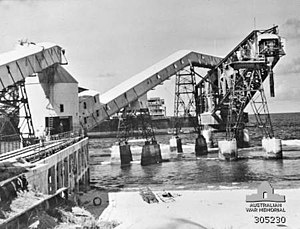German attacks on Nauru
| German attacks on Nauru | |||||||
|---|---|---|---|---|---|---|---|
| Part of World War II | |||||||
 Damaged phosphate cantilever loading equipment following the German bombardment of Nauru on 27 December 1940 |
|||||||
|
|||||||
| Belligerents | |||||||
|
|
|
||||||
| Commanders and leaders | |||||||
|
|
|||||||
| Strength | |||||||
| 2 auxiliary cruisers 1 oiler |
No military presence | ||||||
| Casualties and losses | |||||||
| None | 5 merchant ships sunk Damage to phosphate loading facilities |
||||||
The German attacks on Nauru refers to the two attacks on Nauru in December 1940. These attacks were conducted by auxiliary cruisers between 6 and 8 December and on 27 December. The raiders sank five Allied merchant ships and inflicted serious damage on Nauru's economically important phosphate-loading facilities. Despite the significance of the island to the Australian and New Zealand economies, Nauru was not defended and the German force did not suffer any losses.
The two attacks were the most effective operations conducted by German raiders in the Pacific Ocean during World War II. They disrupted supplies of phosphate to Australia, New Zealand and Japan, which reduced agricultural production in these countries. In response, Allied naval vessels were deployed to protect Nauru and nearby Ocean Island and escort shipping in the South Pacific. Small garrisons were also established to protect the two islands.
Nauru and nearby Ocean Island were important sources of phosphate for Australian and New Zealand fertilizer production and played an important role on both countries agriculture industries at the time of World War II. The Melbourne-based British Phosphate Commission (BPC) managed the extraction and export of phosphate from the islands and dominated all aspects of Nauruan life. During the year ending 30 June 1940, the BPC shipped almost a million tons of phosphate from Nauru and about half that amount from Ocean Island using its fleet of four vessels (Triadic, Triaster, Triona and Trienza) and chartered merchant ships.
As the islands have no harbours or anchorages, the phosphate ships were loaded by securing to deep moorings and embarking their cargo via cantilever jetties. During south-westerly wind periods—which are common from November to March—the ships had to stop loading and sail away from the island until conditions improved. It was common for these ships to be allowed to drift to save fuel, and there were often several vessels lying off Nauru.
...
Wikipedia
